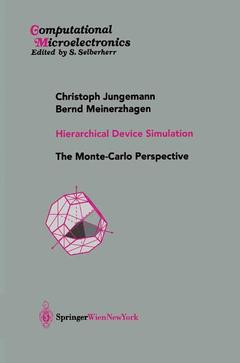Hierarchical Device Simulation, Softcover reprint of the original 1st ed. 2003 The Monte-Carlo Perspective Computational Microelectronics Series
Langue : Anglais
Auteurs : Jungemann Christoph, Meinerzhagen Bernd

This book summarizes the research of more than a decade. Its early motivation dates back to the eighties and to the memorable talks Dr. C. Moglestue (FHG Freiburg) gave on his Monte-Carlo solutions of the Boltzmann transport equation at the NASECODE conferences in Ireland. At that time numerical semiconductor device modeling basically implied the application of the drift-diffusion model. On the one hand, those talks clearly showed the potential of the Monte-Carlo model for an accurate description of many important transport issues that cannot adequately be addressed by the drift-diffusion approximation. On the other hand, they also clearly demonstrated that at that time only very few experts were able to extract useful results from a Monte-Carlo simulator. With this background, Monte-Carlo research activities were started in 1986 at the University of Aachen (RWTH Aachen), Germany. Different to many other Monte-Carlo research groups, the Monte-Carlo research in Aachen took place in an environment of active drift-diffusion and hydrodynamic model development.
1 Introduction.- References.- 2 Semiclassical Transport Theory.- 2.1 The Boltzmann Transport Equation.- 2.2 Balance Equations.- 2.3 The Microscopic Relaxation Time.- 2.4 Fluctuations in the Steady-State 25 References.- 3 The Monte-Carlo Method.- 3.1 Basic Monte-Carlo Methods.- 3.2 The Monte-Carlo Solver of the Boltzmann Equation.- 3.3 Velocity Autocorrelation Function.- 3.4 Basic Statistics.- 3.5 Convergence Estimation.- References.- 4 Scattering Mechanisms.- 4.1 Phonon Scattering.- 4.2 Alloy Scattering.- 4.3 Impurity Scattering.- 4.4 Impact Ionization by Electrons.- 4.5 Surface Roughness Scattering.- References.- 5 Full-Band Structure.- 5.1 Basic Properties of the Band Structure of Relaxed Silicon.- 5.2 Basic Properties of the Band Structure of Strained SiGe.- 5.3 k-Space Grid.- 5.4 Calculation of the Density of States.- 5.5 Mass Tensor Evaluation.- 5.6 Particle Motion in Phase-Space.- 5.7 Selection of a Final State in k-Space.- References.- 6 Device Simulation.- 6.1 Device Discretization.- 6.2 Band Edges.- 6.3 Poisson Equation.- 6.4 Self-Consistent Device Simulation.- 6.5 Nonlinear Poisson Equation.- 6.6 Nonself-Consistent Device Simulation.- 6.7 Statistical Enhancement.- 6.8 Terminal Current Estimation.- 6.9 Contact Resistance.- 6.10 Normalization of Physical Quantities.- References.- 7 Momentum-Based Transport Models.- 7.1 The Hydrodynamic Model.- 7.2 Small-Signal Analysis.- 7.3 Noise Analysis.- 7.4 The Drift-Diffusion Model.- 7.5 Transport and Noise Parameter Simulation.- References.- 8 Stochastic Properties of Monte-Carlo Device Simulations.- 8.1 Stochastic Error.- 8.2 In-Advance CPU Time Estimation.- References.- 9 Results.- 9.1 N+NN+ and P+PP+ Structures.- 9.2 MOSFETs.- 9.3 SiGe HBTs.- References.
First monograph on physics-based simulations of novel strained Si and SiGe devices In-depth description of the full-band monte-carlo method for SiGe Comprehensive description of the momentum-based and monte-carlo models is given
Date de parution : 09-2012
Ouvrage de 261 p.
15.5x23.5 cm
Date de parution : 06-2003
Ouvrage de 261 p.
15.5x23.5 cm
Thèmes de Hierarchical Device Simulation :
Mots-clés :
Analysis; Monte-Carlo Simulation; Norm; Signal; Transport; computer-aided design (CAD); microprocessor; model; physics; simulation; statistics
© 2024 LAVOISIER S.A.S.



